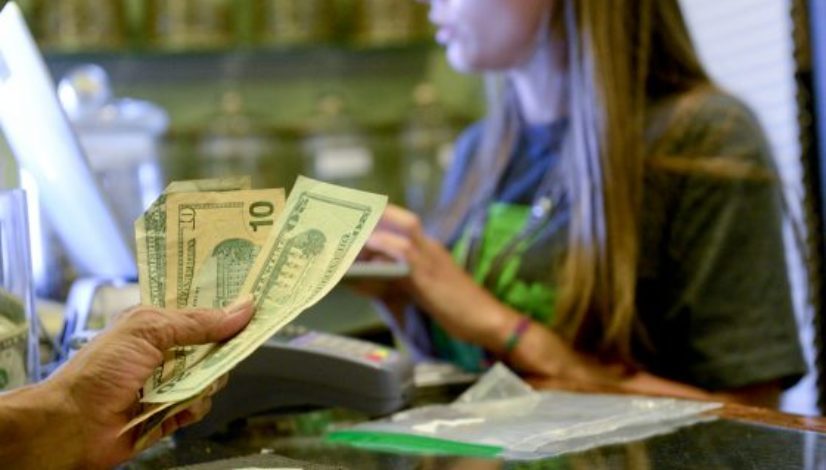Cannabis industry not king in Colorado economy: new report

Colorado’s marijuana industry is booming and boisterous, but the burgeoning business sector is a mere blip on the state’s broader employment and revenue picture.
Denver-based economists at the Federal Reserve Bank of Kansas City this week published a snapshot of the marijuana industry’s economic effects in Colorado, which in 2014 became the first state to implement legal adult-use cannabis sales.
“As the first state to open recreational marijuana retail stores, Colorado provides a case study to examine the potential economic effects from legalization,” wrote Alison Felix, vice president and Denver branch executive, and Sam Chapman, associate economist in the latest issue of the Rocky Mountain Economist quarterly publication.
Here’s what economists found when they compared the latest marijuana revenue, tax and employment data to other business sectors and the state’s overall economic performance:
Sales
Consumer spending in Colorado totaled $236.3 billion in 2016, the most current available data on personal consumption expenditures.
Marijuana sales that year rang up north of $1.3 billion, representing a 0.55 percent share of that statewide consumer spending. By comparison, the economists noted, food and beverages purchased for off-site consumption — think going grocery shopping — accounted for 7.2 percent of consumer spending.
In 2017, Colorado retail and medical marijuana shops tallied at least $1.5 billion in sales, according to Colorado Department of Revenue data that do not include revenue from individual cities’ marijuana sales tax.
New Business Formation
Colorado’s cannabis industry accounts for a small share of the state’s new businesses, the economists noted.
They compared the more than 3,000 marijuana-related business licenses active at the end of 2017 to the 431,997 new entity business filings made between 2014 and 2017 to determine that cannabis businesses would represent about 0.7 percent of new business launched since 2014.
And that 0.7 percent might be generous.
“The actual percentage likely is lower than 0.7 percent because some marijuana-related businesses existed in Colorado prior to 2014, particularly those serving the medical side of the industry,” they wrote.
Employment
The marijuana industry employment comprises 0.7 percent of jobs in Colorado, the report found.
Applying the Marijuana Policy Group’s full-time equivalent calculation of 0.467 to the 38,000 issued licenses as of the end of March, the fed economists estimated Colorado’s marijuana industry employs about 17,821 full-time equivalent employees.
However, the cannabis industry has done its part to fuel job growth within the state, the authors said.
About 5.5 of Colorado’s employment growth in the first half of the 2017 can be attributed to the cannabis industry, the economists said. By comparison, leisure and hospitality was the state’s largest job-growth generator at 23 percent, and mining and logging was responsible for nearly 7 percent of total employment growth in the first half of last year, the economists said.
“Employment in the marijuana industry is a relatively small share of total employment in Colorado, but in recent years it has been one of the state’s fastest-growing industries,” they said, noting the cannabis industry’s 17.7 percent year-over-year uptick in jobs from 2016.
Taxation
As the marijuana industry has filled out in Colorado, the state’s coffers have gotten a jolt — including a $247 million infusion in 2017.
“To put the magnitude of marijuana tax collections in perspective, they equate to about 2.3 percent of Colorado’s 2017 general fund revenue,” they wrote. “Although this calculation is useful for perspective, most marijuana revenue does not go into the state general fund.”
Marijuana tax monies received by the state are doled out to a variety of recipients. For example, the first $40 million from excise taxes on wholesale cannabis goes to the Building Excellent Schools Today school construction program with any excess landing in the Public School Fund.
Ten percent of collections from the special 15 percent sales tax on retail marijuana is distributed to local governments, which may be collecting special sales taxes for the purview of the respective city.
The remaining 90 percent of tax revenue will be distributed differently starting in July, the start of the new fiscal year:
- 15.56 percent will go to the general fund
- 12.59 percent will go to the public school fund
- 71.85 percent will go to the marijuana tax cash fund, which goes toward regulation, licensing, law enforcement, treatment services, substance abuse prevention, administration costs, monitoring health effects and health education.
Unforeseen consequences
The authors wrapped their economic look-in with a glance at the “potential costs” of marijuana legalization, including data showing marijuana usage increasing from 2006 to 2014; hospitalizations and poison control calls increasing from the early 2000s to 2015; and traffic fatalities with THC-only or THC-in-combination positive drivers increasing from 2013 to 2014.
“Although legalization has contributed to employment growth and tax revenues in the state, it is important to weigh those benefits against the potential costs to public safety and health outcomes,” the authors wrote.
State officials have said they’re closely monitoring a variety of public health and safety indices to make adjustments to the state program. State officials also have been cautious about drawing hard conclusions, citing a need for more robust, longitudinal data.




